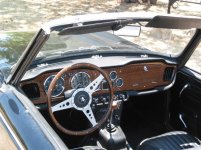This ignition coil with external ballast resistor is bothering me. There's a white wire from power plugged into one end then a blue wire from the resistor to the (+) of the coil. That's it. The (-) goes to the distributor. First of all, this is how it was set up from PO with a positive ground. Shouldn't it have been flipped with pos ground? As I said, I changed it over to negative ground when I installed the fuel pump. I left the power going to (+) and exiting to dizzy through (-).
Second: shouldn't there be another wire or something? I mean, isn't the resistor supposed to be bypassed during startup? How does that happen? If so, would this be causing my problems?
Definitely try another condenser, "just because". They can fail in strange ways that won't show up during a low voltage test. And if it turns out not to be the problem, you can save it for the next tune-up or to carry for an on-board spare.
The coil was connected backwards, but it only makes a small difference anyway. Having it backwards might make the engine fractionally harder to start but generally it won't even be noticeable. And you've got it right now, so that's OK.
Likewise, the connection to short out the ballast during starting is optional. It was added later to improve starting in extremely cold weather; but usually it won't make any noticeable difference. It only does anything during starting anyway, which doesn't seem to be your complaint. And after all, that is the way the car was originally (although the resistance was inside the coil rather than outside).
The only question I have is whether that coil really requires an external ballast or not. I couldn't find it listed in my (old) Lucas documentation. Might be worth double-checking the primary resistance (which should be around 1.5 ohms if it needs the ballast; around 3.0 ohms if not). Or just trying a different coil. Coils also can sometimes fail in strange ways. And a couple of years ago, I had a nearly new Lucas coil do something similar (although in my case, the engine was also abnormally hard to start).
FWIW, I ran an external ballast and a cheap, non-Lucas coil for several years, back when I lived in a colder climate. After the alternator conversion (and the biggest battery I could buy), that TR3A would start even when others would not! I used to give other people jump starts in cold weather.

 Hi Guest!
Hi Guest!

 smilie in place of the real @
smilie in place of the real @
 Pretty Please - add it to our Events forum(s) and add to the calendar! >>
Pretty Please - add it to our Events forum(s) and add to the calendar! >> 



